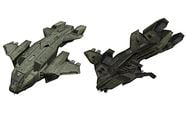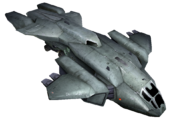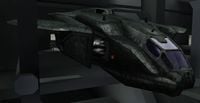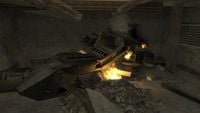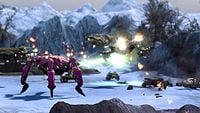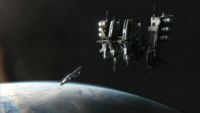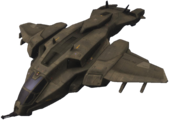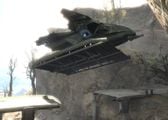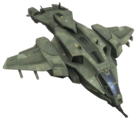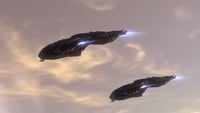D77-TC Pelican
From Halopedia, the Halo wiki
| This article does not have enough inline citations and/or does not adhere to the proper citation format. You can help Halopedia by adding citations. |
The D77-TC Pelican, formally known as the Dropship 77-Troop Carrier and commonly known as the Pelican, is an extremely versatile space-to-ground capable craft used by the United Nations Space Command, mainly for the pickup and transportation of personnel, vehicles and equipment, as well as a powerful gunship.
The D77-TC Pelican is mainly responsible for the rapid insertion and extraction of troops, vehicles, and equipment to the battlefield. The D77-TC has been in service for over fifty years, and is the primary tactical support aircraft of the UNSC. The Pelican serves a multi-role purpose; it is fully capable of atmospheric flight and can land almost anywhere without difficulty. The Pelican is also capable of limited spaceflight, which the UNSC uses as a primary way of delivering troops to the surface from orbit. The UNSC also uses Pelicans as civilian vehicles for quick evacuations.[1][2]
The Pelican's standard armament consists of one Class III externally powered projectile weapon at the fore of the vehicle, and one Class I gas-operated projectile weapon mounted at the rear, in the extended crew area. More heavily armed variants exist, and the Pelican can be converted to a gunship role with the addition of numerous and more powerful weaponry.[3]
Design
Payload capacity
The Pelican is capable of carrying up to seventy tons of passengers and cargo using a combination of internal and external methods. The main compartment of the Pelican is sometimes called the "blood tray".[4] Optimally, the "blood tray" has enough compartment space for ten seated people, but can hold five additional standing people, though the Pelican can carry many more passengers if necessary.[5] However, this increased payload capacity is sometimes due to internal modification. For example, the SPARTAN-IIs were assigned a specialized Pelican that was able to hold an entire team of twenty-five, as well as fitting cutting gear to board a Covenant warship. Three Pelicans used for the SPARTAN-III Program carried 300 children, though this may have been the effort of numerous trips back and forth from the surface.[citation needed]
The large aft overhang gives an attachment point for additional cargo and ordnance. Possible payloads include a troop deployment pod, an M808B Main Battle Tank, an M12 Force Application Vehicle, or eight resupply canisters.
Armament
The Pelican's primary armament consists of one or more nose-mounted projectile weapons, typically autocannons or machine guns. Commonly known as "chin guns" due to their placement,[6] these weapons are controlled via an Integrated Helmet and Display Sight System (IHADSS), which links to the pilot's or co-pilot's heads-up display and allows them to target the gun by head movements.[5][7] The Pelican's standard armament is a chin-mounted M370 autocannon, which is sometimes linked with another such weapon;[8] the M370, which fires 70mm depleted uranium slugs a high velocities, apparently superseded the 40mm chain gun that was common prior to 2525.[9] Some Marine Corps Pelicans are armed with a single a rotary machine gun instead of a chain gun.[10]
In addition to its primary armament, the Pelican can carry externally mounted missile pods, each holding eight ANVIL-II Air-to-Surface Missiles. A machine gun such as an M247 General Purpose Machine Gun with an optional 25mm grenade launcher,[10] or an AIE-486H Heavy Machine Gun, can be mounted facing out the troop bay to provide cover fire for embarking and disembarking troops. These weapons can be folded against the roof of the bay when not in use.
Propulsion
The main engines are mounted in pairs in four nacelles, one on each wing and two at the rear. The nacelles can articulate independently, thus vectoring the direction of thrust and improving the dropship's low-altitude maneuverability. Six ventral thrusters, two on each wing nacelle and one on each aft nacelle, allow the Pelican to land and take off vertically. These engines are capable of both space and atmospheric operation. The D77-TC, although fully capable of orbital insertion, is too small to be equipped with a Shaw-Fujikawa Translight Engine, and thus is incapable of slipspace travel.[citation needed]
Additional features
The Pelican's electronic systems are hardened against electromagnetic pulse. The craft also features jamming and detection gear, as well as a computerized mapping system. The Pelican is also equipped with an onboard weapons locker, which can hold weapons and ammunition for up to 30 troops.[5]
Variants
D77H-TCI
- Main article: D77H-TCI Pelican
The D77H-TCI appears nearly identical to the regular D77-TC except for being more angular. However, instead of the side-by-side positioning of the pilot and copilot, the pilot sits at the fore of the dropship, with the co-pilot behind him/her, and at a higher position, in tandem. The D77H-TCI is capable of sporting missile pods that are integrated directly into the wings rather than the externally mounted pods used by the D77.
Law enforcement
- Main article: D77C-NMPD Pelican
The D77C-NMPD is a variant of the D77H-TCI that was utilized by the New Mombasa Police Department in Kenya, Africa, on Earth.[11] It was differentiated from its military counterpart by a black and white color scheme, with the word "POLICE" replacing the traditional "MARINES" on the external hull, and a noted lack of armament. Under the craft's chin, where a machine gun turret or autocannon would normally be installed, were various interchangeable sensors used by the police for aerial surveillance and crowd control. An AIE-486H Heavy Machine Gun was typically mounted in the personnel bay of the D77C-NMPD, similarly to the D77 and D77H models.
UNSC Air Force variant
The version of the Pelican used by the UNSC Air Force features a few major differences from other variants of the aircraft. First, the cockpit layout resembles that of the newer D77H-TCI model with the co-pilot's station located behind and above the pilot rather than side-by-side. Also, most Air Force Pelicans have chin-mounted M638 autocannons rather than the 40mm or 70mm weapons typically mounted on Marine Corps Pelicans. Another difference seen in Air Force Pelicans is that the cockpit is not separated from the troop bay; instead the troop bay and cockpit form a larger interior space than on the Navy and Marine Corps Pelicans.[citation needed]
Identified Pelicans
Halo: Fleet Battles
UNSC Pelican Boarding Craft
- Flight slots: 0
- Movement: 12"
- Damage track: 4
- Security detail: 2
- Systems loadout: Heroic save (Trooper)
Trivia

|
Browse more images in this article's gallery page. |
- A pelican is a seabird, in keeping with the UNSC's tradition of naming atmospheric vehicles after real animals, with the exceptions of the Cyclops and Gremlin, which are named after mythical creatures, and the Longsword, Shortsword, Sabre, and Broadsword which are named after bladed weapons.
- All Pelican dropships in Halo: Combat Evolved bear either the numbers E419 (Echo 419) or V933 (Victor 933). This was likely done to save resources during the development of the game.
- The Pelican shows clear inspiration from the UD4L Cheyenne dropship from the movie Aliens, which has inspired the Halo series in many ways.
- In Halo 2 gameplay, players can see the insides of the Pelican's cockpit, but no pilots are inside, despite they can be heard in COMs.
- There is a glitch in the Halo 2 level Metropolis where the player can ride in a Pelican. It will take the player out of the map, flip, and eject the player. If the player attempts to right the flipped Pelican, the script will read "Hold X to flip Banshee", because Bungie never intended for the Pelican to be operable by the player, and therefore did not make a unique message. The Pelican's in-game physics will make it impossible to correctly and permanently flip the Pelican, as it will always reposition itself in an upside-down position.
- In Halo: Reach, the player can pilot a Pelican through an Easter egg.
- In Halo: Reach, the inside screens show information on the Office of Naval Intelligence's SWORD Base.
- In Halo: Reach, all Pelicans are registered as NOBLE Team assets, as they are all given the tag "NOBLE 48".
Gallery
- Concept-HCE-Early-Pelican.jpg
Early concept art for the Pelican for Halo: Combat Evolved.
- PelicanII-Sil.gif
Schematics of a D77-TC.
- Pelican-Scorpion.jpg
Side preview of a Pelican carrying a Scorpion.
- Pelican-Warthog.jpg
Side preview of a Pelican carrying a Warthog.
An angled profile view of a Pelican in Halo: Combat Evolved Anniversary.
Two Pelicans during the Battle of the Silent Cartographer.
- Phantom and Pelican.png
A Pelican with a woodland camouflage scheme in Halo Wars: Genesis.
A squadron of Hornets and Sparrowhawks protect a number of Pelican dropships from a Protos Scarab in an early build of Halo Wars.
- PelicanOnHarvest.JPG
Three Pelicans during the Harvest Campaign in Halo Wars.
A Pelican approaches the Template:UNSCship in Birth of a Spartan short live-action film.
- EarlyPelicanRedesign.jpg
Early concept of a redesigned Pelican for Halo: Reach.
- PelicanAirfieldConcept.jpg
Concept art of a Pelican airfield on Reach.
A Pelican during the Battle at Szurdok Ridge.
A Pelican carrying a deployable bridge.
The crashed Bravo 001 in the Military Wilderness Training Preserve.
A cutout of a Pelican in Halo 2: Anniversary.
Sergeant Avery Johnson commandeers a Pelican's M247 bay gun.
List of appearances
- Halo: The Fall of Reach (First appearance)
- Halo: Combat Evolved
- Halo: The Flood
- Halo: First Strike
- Halo: Fleet Battles
- Halo 2
- Halo Graphic Novel
- Halo: Ghosts of Onyx
- Halo: The Cole Protocol
- Halo Wars: Genesis
- Halo Wars
- Halo Legends
- Halo: Evolutions - Essential Tales of the Halo Universe
- Remember Reach
- Halo: Reach
- Halo: Fall of Reach
- Halo: Combat Evolved Anniversary
- Scanned
- Halo 2: Anniversary
- Hunt the Truth (Mentioned only)
- Halo: Spartan Strike
- Halo: Fleet Battles
- Halo: The Fall of Reach (animated series)
Sources
- ^ Halo: Reach, campaign level Exodus
- ^ Halo: Uprising
- ^ Halo 4, campaign level Shutdown
- ^ Halo: Ghosts of Onyx, page 203
- ^ a b c Halo: Combat Evolved: Sybex Official Strategies & Secrets, page 66
- ^ Cite error: Invalid
<ref>tag; no text was provided for refs namedEVG - ^ Halo: the Flood, page 77
- ^ Halo: Ghosts of Onyx, page 40
- ^ Cite error: Invalid
<ref>tag; no text was provided for refs namedTFoR - ^ a b Cite error: Invalid
<ref>tag; no text was provided for refs namedHalo 2 - ^ Halo Waypoint: D77C-NMPD Pelican
